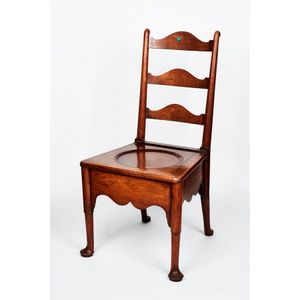Giltwood and Painted Chairs from Webb Collection
Louis XVI style giltwood side chair, together with a white painted side chair with carved top rail above a carved vase and lyre splat, both chair with pink upholstery (2). provenance: The Collection of Janet and Graeme Webb, Wollogorang, NSW
You must be a subscriber, and be logged in to view price and dealer details.
Subscribe Now to view actual auction price for this item
When you subscribe, you have the option of setting the currency in which to display prices to $Au, $US, $NZ or Stg.
This item has been sold, and the description, image and price are for reference purposes only.
- Rail - A term used by cabinet makers for the horizontal sections of the frame of an item such as a chair or settee which have a front rail, a back rail and two side rails, and also on a door or carcase, where the rails are joined to the vertical framings.
- Provenance - A term used to describe the provable history of an antique or work of art, and thus an additional aid to verifying its authenticity. Provenance can have an inflating effect on the price of an item, particularly if the provenance relates to the early settlement of Australia, a famous person, or royalty. Less significant are previous sales of the item through an auction house or dealer.
- Splat - The central back support between the top rail and the seat in chairs and couches. They may take a variety of forms, and run either horizontally or vertically.
- Giltwood - Giltwood is used to describe a gold finish on furniture and other decorative wooden items, whereby a thin sheet of gold metal, called gold leaf, is applied to the surface for decorative purposes.
Unlike gilding, where the gold leaf is applied over a coating of gesso, with giltwood the gold leaf is applied direct to the surface, or over a coat of linseed oil gold leaf adhesive.
Most gold-finished mirrors will be gilded, whereas furniture with gold highlights will have the gold applied through the giltwood method. - Lyre - Attributed to the 18th century designer Robert Adam, the back splat of a chair or sthe supports of a table are in the form of a lyre, a Greek musical instrument similar to a harp.
In shape it resembles two reversed scrolls.
Chairs continued to be made in this style for at least the next fifty years.
In Australia many cedar chairs and tables have survived dating to the 1830s and 1840s, featuring the lyre shape in the back splats and as supports for small tables. - Lyre Motif - The lyre motif is an ancient decorative design that is believed to have originated in ancient Greece, where the lyre was a popular musical instrument. The lyre itself was often decorated with ornate carvings and designs, including the iconic lyre motif.
In ancient Greek mythology, the lyre was associated with the god Apollo, who was the patron of music and the arts. The lyre was said to have been invented by the god Hermes, who presented it to Apollo as a gift. As a result, the lyre became a symbol of creativity, inspiration, and artistic expression.
The lyre motif typically features a curved or S-shaped body, with strings extending upwards from the base. The motif was often used in architectural decoration, as well as on pottery, jewellery, and other decorative objects.
This item has been included into following indexes:
Visually similar items

A George I style mahogany leather back side chair covered in pistachio leather
Sold by
in
for
You can display prices in $Au, $US, $NZ or Stg.

Two wing backed armchairs, standing on cabriole shaped legs with shell carving and claw feet
Sold by
in
for
You can display prices in $Au, $US, $NZ or Stg.

Victorian mahogany commode chair, 19th century, with ladder back and shaped apron, height 99 cm
Sold by
in
for
You can display prices in $Au, $US, $NZ or Stg.

A good 19th century Australian cedar Wet Nurse chair upholstered in Warner silk brocade fabric
Sold by
in
for
You can display prices in $Au, $US, $NZ or Stg.
